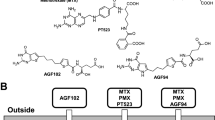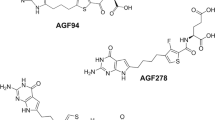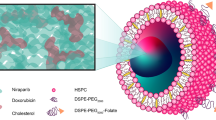Abstract
Lometrexol (5,10-dideazatetrahydrofolic acid; DDATHF), is a specific inhibitor of glycinamideribonucleosyl (GAR) transformylase with anti-tumour activity in murine and human carcinomas. The cytotoxicity activity of DDATHF was evaluated in vitro in NIH/3T3 cells transfected with human alpha-folate-binding protein (FBP) complementary DNA to examine the role of the receptor. In FBP-transfected NIH/3T3 (FBP-tNIH/3T3) cells, which internalised about three times more 5-methyltetrahydrofolic acid than the mock-transfected cells, the cytotoxtic potential of DDATHF showed a clear increase. Subsequently, we analysed four ovarian carcinoma cell lines (OVCAR3, IGROV1, SKOV3, and SW626) expressing different amounts of FBP. Cells were conditioned to grow in medium depleted of folic acid then tested by MOv18 and folic acid binding. Only SKOV3 and SW626 cells grown in folic acid-depleted medium showed increased FBP expression, about 3- and 8-fold respectively. The cytotoxic potential of DDATHF was evaluated by a standard clonogenic assay. In a medium containing 2.27 microM folic acid the DDATHF IC50 values were 50 nm on OVCAR3, 500 nM on SW626 and 1000 nM on IGROV1. In folic acid-free medium IC50 values were 2 nM on OVCAR3 and Sw626 and 40 nM on IGROV1. Only on SKOV3 cells was DDATHF cytotoxicity the same regardless of the amount of folic acid in the medium (IC50 8 nM). Thus, DDATHF did not inhibit the growth of IGROV1 cells depleted of folic acid after stripping FBP with phosphatidylinositol-phospholipase C, even at a dose toxic for cells constitutively expressing FBP. Although FBP expression is certainly one of the parameters affecting drug toxicity, taken alone it is not a sufficiently reliable predictor of cancer cell sensitivity to DDATHF.
This is a preview of subscription content, access via your institution
Access options
Subscribe to this journal
Receive 24 print issues and online access
$259.00 per year
only $10.79 per issue
Buy this article
- Purchase on Springer Link
- Instant access to full article PDF
Prices may be subject to local taxes which are calculated during checkout
Similar content being viewed by others
Author information
Authors and Affiliations
Rights and permissions
About this article
Cite this article
Sen, S., Erba, E., D'Incalci, M. et al. Role of membrane folate-binding protein in the cytotoxicity of 5,10-dideazatetrahydrofolic acid in human ovarian carcinoma cell lines in vitro. Br J Cancer 73, 525–530 (1996). https://doi.org/10.1038/bjc.1996.91
Issue Date:
DOI: https://doi.org/10.1038/bjc.1996.91



